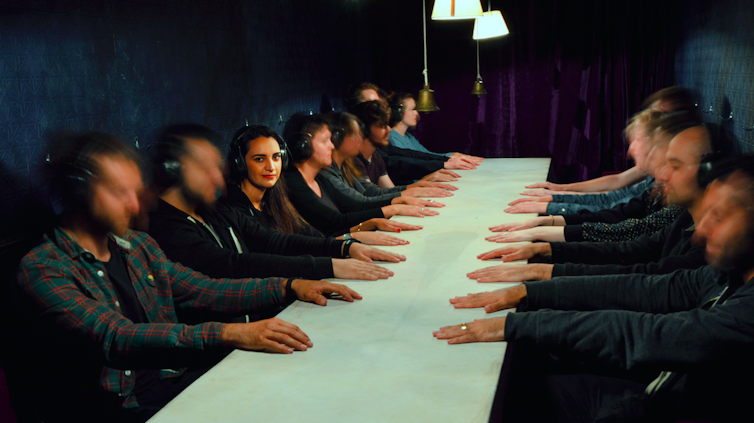Feeling fear is our response to threat and danger. It makes us choose between staying and freezing or fighting, or – often more wisely – fleeing as quickly as possible. Feeling the fear is one of the few basic emotions that is probably innate, and that is exhibited by many other creatures. An animal that can quickly flee danger will stand a good chance of surviving long enough to add to the gene pool.
When I was ten, my Uncle Chris took me on the ghost train at the fair. I had looked forward to that trip so much; as an imaginative child I devoured ghost stories, and wondered if night terrors were manifestations trying to claw their way over from the other side.
But how disappointed I was. The train was just a jerky little carriage that bumped along on rails, a few pre-recorded shrieks, some luminescent paint, a frond of wet material that was probably a used mop, and at some point, a man in black jumping out shouting “BWAAAH!”
I wasn’t scared then, and I’m not sure I’ve been frightened of anything much since. So last week when I went to see a performance of Séance at the Edinburgh Fringe festival, described as “an intense sonic performance for 20 people that lasts for 15 terrifying minutes”, I was looking forward to a proper spooking.
Is there anybody out there?
Sadly, it wasn’t even as good as the ghost train I went on many years ago, although there were similarities. With a group of 19 other people, I sat in a pitch-black shipping container for a quarter of an hour with some suspiciously clammy headphones emitting binaural sounds and voices that described a séance going wrong.

Disastrous séances have been done to death over the last few hundred years. The only novelty here was the pitch blackness and the sound effects, but the script wasn’t strong enough to overcome the limitation that we all knew: that whatever happened, we were perfectly safe.
But not that much happened. Things weren’t helped by my being at the end of a row so that I knew the voices from my left could only be coming from the headphones, not some spectre passing overhead. It was all a bit of a let-down; not one delicious shiver of fear passed through my body.
Fear is our response to threat and danger. It makes us choose between staying and freezing or fighting, or – often more wisely – fleeing as quickly as possible. Fear is one of the few basic emotions that is probably innate, and that is exhibited by many other creatures. An animal that can quickly flee danger will stand a good chance of surviving long enough to add to the gene pool.
Poor little Albert feeling the fear
The biological changes in an organism in response to a threat conserve energy so that we can flee faster or fight better, and include sweating, dilation of the central blood vessels and increased muscle tension.
There’s a large cognitive component to fear, in that we learn to be afraid of particular stimuli, and learn to evaluate them in particular ways. The classic example is psychologist John B Watson’s induction of fear in the infant Little Albert by pairing the appearance of a white rat to sudden unpleasant loud sounds.
The poor child showed what is called stimulus generalisation in also being frightened of other white animals and even fluffy material. It is thought that we acquire phobias, which are inappropriate fear responses, by the same process of classical conditioning that gave Albert his fear of white rabbits.
The amygdala, a pair of small almond-shaped nuclei deep in each hemisphere of the brain, play an essential role in detecting threat, which then leads to the generation of the fear response. Damage to the amygdala in monkeys and humans leads to a complex syndrome of behaviours known as Klüver-Bucy Syndrome, including extreme docility and inapparent ability to detect threatening stimuli. The animal can no longer be afraid of frightening things. There is some evidence that psychopaths have smaller, malformed amygdala, which makes sense given their reduced levels of fear.
Read more…
Emotional Agility Is Important For Long Term Happiness, Health and Success
The damage we’re doing to our children and ourselves
But, alas, I am no psychopath, and there are many situations in which I can imagine feeling plenty of fear. The prospect of going over the top in the First World War trenches is terrifying, or being in the boats approaching the Normandy shore as depicted in Steven Spielberg’s Saving Private Ryan. The idea of being in a plane as it plummets to earth has a similar effect.
Yet in everyday life I don’t think I feel fear very often. I struggle, in fact, to understand what real fear must be like. I can envisage what it must have been like being in the trenches, and I can imagine the fear, but I can’t make myself feel the fear.
Is modern life too safe?
Most of what people think of as fear is just the knowledge that something unexpected is going to happen, such as when we watch horror films; we aren’t truly frightened. Few of us feel any real fear in such a situation. Indeed much of modern life is now fear-free. This basic animal emotion is just not something most of us experience very often.

Although more pleasant, our lives are a little impoverished. If we hardly ever experience fear, we are less able, perhaps, to empathise with others who are in truly frightening situations. A chastening near-miss while driving can make us afraid, and might make us safer drivers, if only for a while. But humans often take too many risks, which in part is because our modern lives provide us with too few frightening scenarios.
Read more…
Governments Have Destroyed The Tribe: We Do Not Know Who or What We Are Anymore
It Takes a Tribe To Raise Child And To Ensure They Have A Long Happy Life… Part 1 and Part 2
If not enough fear is a danger of modern Western life, too much fear is worse. Prolonged exposure to fearful stimuli leads to stress, which is very bad for us. It elevates levels of the “stress hormone” cortisol, which in excess leads to system-wide inflammation, immune system suppression, mental illness, and even cell death. Too much fear can also result in post-traumatic stress disorder (PTSD), which can lead to serious mental health problems.
Perhaps I would have felt some fear at the performance of Séance if I had believed that there was a chance that the container door would jam shut and the oxygen might run out. Or the container had been perched on the top of a cliff, and once inside it had started sliding towards the edge. But no. It just sat there on a noisy Edinburgh street. I will have to seek my thrills elsewhere.
Trevor Harley, Head and Dean of School of Psychology, University of Dundee
This article is republished from The Conversation under a Creative Commons license. Read the original article.

